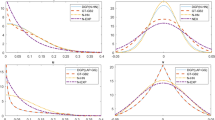Abstract
We consider goodness–of–fit tests for the distribution of the composed error in Stochastic Frontier Models. The proposed test statistic utilizes the characteristic function of the composed error term, and is formulated as a weighted integral of properly standardized data. The new test statistic is shown to be consistent and computationally convenient. Simulation results are presented whereby resampling versions of the new tests are compared to classical goodness–of–fit methods.
Similar content being viewed by others
References
Aigner DJ, Lovell CAK, Schmidt P (1977) Formulation and estimation of stochastic frontier models production function models. J Econometr 6:21–37
Amsler C, Papadopoulos A, Schmidt P (2021) Evaluating the cdf of the skew normal distribution. Empiric Econom 60:3171–3202
Amsler C, Schmidt P, Tsay WJ (2019) Evaluating the CDF of the distribution of the stochastic frontier composed error. J Product Anal 52:29–35
Babu GJ, Rao CR (2004) Goodness–of–fit tests when parameters are estimated. Sankhya 66:63–74
Bera, A. K., Mallick, N. C. (2002) Information matrix tests for the composed error frontier model. In: Balakrishnan N (Ed) Advances on methodological and applied aspects of probability and statistics. Gordon and Breach Science Publishers, London
Chang J, Hall P (2015) Double–bootstrap methods that use a single double-bootstrap simulation. Biometrika 102:203–214
Chen YT, Wang HJ (2012) Centered-residuals-based moment estimator and test for stochastic frontier models. Econometr Rev 31:625–653
Coelli T (1995) Estimators and hypothesis tests for a stochastic frontier function: A Monte Carlo analysis. J Product Anal 6:247–268
Giacomini R, Politis DN, White H (2013) A warp-speed method for conducting Monte Carlo experiments involving bootstrap estimators. Econometr Theory 29:567–589
Henze N, Meintanis SG (2002) Goodness–of–fit tests based on a new characterization of the exponential distribution. Commun Statist - Theor Meth 31:1479–1497
Henze N, Meintanis SG (2005) Recent and classical tests for exponentiality: a partial review with comparisons. Metrika 61:29–45
Jammalamadaka SR, Taufer E (2003) Testing exponentiality by comparing the empirical distribution function of the normalized spacings with that of the original data. J Nonparametr Statist 15:719–729
Jiang J (2010) Large Sample Techniques for Statistics. Springer, New York
Kopp RJ, Mullahy J (1990) Moment-based estimation and testing of stochastic frontier models. J Econometr 46:165–183
Kumbhakar SC, Lovell KCA (2000) Stochastic Frontier Analysis. Cambridge University Press, Cambridge, UK
Lee LF (1983) A test for distributional assumptions for the stochastic frontier functions. J Econometr 22:245–267
Meeusen W, van den Broeck J (1977) Efficiency estimation from Cobb-Douglas production functions with composed error. Inter Econom Rev 18:435–444
Meintanis SG (2007) A Kolmogorov-Smirnov type test for skew normal distributions based on the empirical moment generating function. J Statist Plann Inferen 137:2681–2688
Papadopoulos A, Parmeter CF (2021) Type II failure and specification testing in the stochastic frontier model. Europ J Operat Resear 293:990–1001
Sasvári, Z. (2013) Multivariate Characteristic and Correlation Functions. De Gruyter: Berlin
Schmidt P, Lin T (1984) Simple tests of alternative specifications in stochastic frontier models. J Econometr 24:349–361
Tsionas EG (2000) Full likelihood inference in normal-gamma stochastic frontier models. J Product Anal 13:183–205
Tsionas EG (2012) Maximum likelihood estimation of stochastic frontier models by the Fourier transform. J Econometr 170:234–248
Wang WS, Amsler C, Schmidt P (2011) Goodness of fit tests in stochastic frontier models. J Product Anal 35:95–118
Wheat P, Stead AD, Greene WH (2019) Robust stochastic frontier analysis: a Student’s t half normal model with application to highway maintenance costs in England. J Product Anal 51:21–38
Acknowledgements
The authors express their sincere appreciation for the constructive comments and helpful suggestions of the Associate Editor and two anonymous reviewers.
Author information
Authors and Affiliations
Corresponding author
Ethics declarations
Conflict of interest
The authors declare no competing interests.
Additional information
Publisher’s note Springer Nature remains neutral with regard to jurisdictional claims in published maps and institutional affiliations.
Supplementary Information
Appendices
Appendix A
Starting from Eq. (6) we obtain
where we write ∑j,k for the double sum ∑j∑k. Also recall the trigonometric identities
Now plug the above expression for \({D}_{n}^{2}(t)\) into the test statistic (7) and substitute the above product formulae, and integrate term-by-term the resulting expression. Then after some grouping we obtain (8) by making use of the integrals
Equation (16) may be proved by following analogous steps, but we also need the extra integrals
Appendix B
Starting from Eq. (6) and using \(\sin (z)=z-({z}^{3}/3!)+\ldots\) and \(\cos (z)=1-({z}^{2}/2!)+\ldots\), we obtain (in increasing powers of t)
and by squaring
Plugging the above expression in Eq. (7) and integrating term-by-term leads to
and by taking the limit as λ → ∞, we readily obtain (9), where we made use of the integral
Rights and permissions
About this article
Cite this article
Meintanis, S.G., Papadimitriou, C.K. Goodness--of--fit tests for stochastic frontier models based on the characteristic function. J Prod Anal 57, 285–296 (2022). https://doi.org/10.1007/s11123-022-00632-5
Accepted:
Published:
Issue Date:
DOI: https://doi.org/10.1007/s11123-022-00632-5




